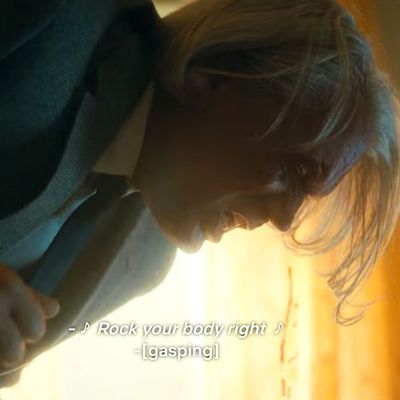
I think it was the very violent fight montage set to “Everybody (Backstreet’s Back)” that broke me. Or maybe not — maybe it was the very violent fight montage set to The Spencer Davis Group’s “I’m a Man.” “I’m a man and I can’t help but love you so,” the singer croons, while one guy impales another guy in a dark room. Maybe I’m wrong, maybe it was the very violent fight montage set to DJ Shadow’s “Rocket Fuel.” Or maybe it was none of those. Perhaps it was the very violent fight montage set to Kiss’s “I Was Made for Lovin’ You.”
Maybe I’m alone. Based on the second season of The Umbrella Academy — the series responsible for all of the above examples — I might well be a standalone curmudgeon on this. But by the time I’d made it to the very violent fight montage set to “Polk Salad Annie,” anything left in me that might once have enjoyed a cheerful, upbeat needle drop playing over a montage of people killing each other had fully, finally snapped.
As with any idea that solidifies into a trope, the peppy song/violent montage pairing exists because it has appeal, and because it works. There’s something particularly effective about the combination of blood spraying across a wall and an effusively happy song — the experience of both elements is deep and pre-intellectual, a brainstem-level response to stimuli. Because one response is pleasure and one is fear/horror/revulsion, and because both of those responses happen at the same time, a peppy song/violent montage can be like the on-screen version of eating a Sour Patch Kid. Your brain registers intense sweetness and intense sourness at once, and the collision of opposites feels so good. It’s televisual Icy Hot.
Like so many delightfully intense things, though, the effectiveness of the combination wanes dramatically with overexposure. And boy has it been overexposed. The idea of a defiantly happy song that plays over some incongruously bleak scene is common enough that it has a well-filled TV Tropes page — the site calls a broader version of this “Soundtrack Dissonance,” and it lists Buffy the Vampire Slayer, Breaking Bad, Criminal Minds, Doctor Who, and ER as repeat offenders of this particular trope. (There are many more examples on that page; those were just a few that jumped out to me as I scrolled alphabetically down the Live-Action TV subsection. Don’t even get me started on movies.)
When you experience the trope over and over again, the sense of friction that makes the concept work gradually starts to fade. The humor of these montages relies on the fundamental frisson of contradiction. These two things don’t fit together! you chuckle as you watch a fight scene set to “Istanbul (Not Constantinople).” But after seeing this done again and again, the effect is dulled. The deep pleasure of watching an unusual combination falls off pretty quickly when the combination is no longer unusual. A thing that was once surprising now feels natural. The delightful cheekiness starts to feel rote.
Worse than rote — it can start to feel lazy. Not to pick on The Umbrella Academy again, but it’s a show that relies heavily on montages of all sorts. Not only are there fight scenes set to upbeat songs, there is also a funeral set to a Swedish cover of Adele’s “Hello,” a dance montage in a barber shop, a “the gang’s all spread apart” montage, and a “the gang’s getting back together” montage. At some point, the show’s constant fast cutting between dozens of sequences comes to feel more like slapdash disorganization rather than (or in addition to being) a deliberate style. It’s the primary way The Umbrella Academy signals its tone. It says: Here are a bunch of sad, lonely, deeply damaged people who live with the constant burden of the end of the world … but it’s also fun! Stuff moves fast! There’s a lot of death, but let’s not dwell on it too much.
Beyond the problem of overuse, I’ve also grown exhausted with the peppy music/violent fight scene structure. Torture, gore, pain, blood, dismemberment, and fancy running kicks that end up smashing someone’s face into a light fixture are all classic tropes of the comic book genre. They’re par for the course; I get it. These things can be artfully done, and they’ve become crucial elements of how these worlds work. While it matters if the main characters stay alive, the other figures — the stooges and random baddies, all with broken limbs and missing teeth — are just grist for the mill. Whistling along to a happy tune while someone’s eye pops out is just an implicit extension of those fictional priorities.
I’ve lost my appetite for it. That no doubt has more to do with my own issues and how I’m processing everything happening in the world than it is a reflection on the genre. It’s hardly The Umbrella Academy’s fault that my personal capacity for enjoying bodily trauma has plummeted in the past few years. What is in that show’s power, though — and is in the power of other movies and TV shows grappling with the same “let’s kill a bunch of goons but also have fun with it” impulse — is to find some new ways to do it. The decision to communicate a sense of saucy violent fun by pairing the fights with ill-fitting music choices no longer feels saucy or fun. It’s time to give those funky needle drops a rest.


